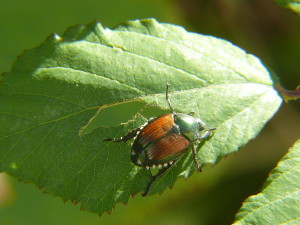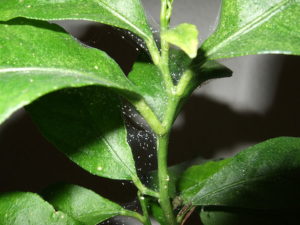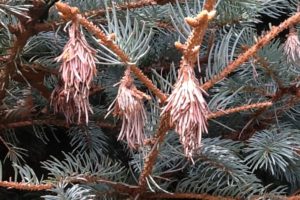Insects thrive during the summer months. As their populations grow and they begin to feed on trees they can do a lot of damage to your landscape. Learn what insects pose a danger to your trees and shrubs and what signs you should keep an eye out for on your property.
1. Sawflies

Sawflies despite the name are not flies at all; they belong to the wasp family and can completely defoliate your tree or shrub in a few short days. The sawfly larva is actually what feeds on trees and plants causing damage. Larvae tend to look like caterpillars with three large legs and seven smaller false legs. Although they may appear individually they are typically seen in groups that feed on the leaves and needles of plant life.
Susceptible Trees: Spruce, Cedar, and Pines
Time Of Year: Early Summer
Signs & Symptoms:
- Holes or papery spots along leaf midribs
- Skeletonized leaves
- Needles may appear brown and wilted
- Complete defoliation or sparse, patchy, missing foliage
- Caterpillar looking larvae on your trees and shrubs (typically in clusters)
- Stunted tree growth
- Shoot death
- Young larvae are often visible, appearing as a caterpillar in large groups
Learn More About Sawflies
2. Japanese Beetles

First brought to the United States in 1916 in a shipment of iris bulbs, this invasive insect can defoliate an entire tree in a matter of days.
Susceptible Trees: Linden, crape myrtle, flowering crabapple, Norway maple, Japanese maple, flowering cherry, elm, sycamore, black walnut, horse chestnut, plums, roses, and many more.
Time of Year: June & July
Signs & Symptoms:
- Large amounts of brown, chewed, skeletonized leaves.
- Leaves falling off trees
- Trees that look scorched by fire from a distance.
- Beetles with a dark metallic green head and metallic dark tan wings on plants & trees.

Learn More About Japanese Beetles
3. Spider Mites

Spider mites are a common enemy of anyone who cares about their landscape plants. Classified as arachnids, these tiny tree bugs are less than 1/20 inch long when fully mature and look like moving dots to the naked eye. Their ability to rapidly reproduce allows large populations to develop fast and severely harm your plants before you even realize you have a problem.
Susceptible Trees: Junipers, Boxwoods, Cryptomeria, Arborvitae, and Leyland Cypress.
Time Of Year: June through September
Signs & Symptoms:
- Stippling of light dots on leaves/needles
- Leaves/needles turning yellow or reddish
- Leaves/needles dropping off
- Webbing covering leaves/needles and twigs
- Tiny moving dots on underside of leaves/needles (what these mites look like to the naked eye)
Learn More About Spider Mites
4. Aphids

Aphids, also known as plant lice, are among the most destructive tree bugs. These small sap-sucking insects are members of the superfamily Aphidoidea. On top of creating honeydew and attracting sooty mold, Aphids weaken the plant and are vectors for other plant diseases. Because of their ability to asexually reproduce aphids rapidly grow in number and are difficult to control/eliminate.
Susceptible Trees: Many species including Ash, Crape Myrtles, Fir, Pine, Spruce, Cedar, Hackberry, Roses, and Tulip Poplars.
Time Of Year: All Summer Long
Signs & Symptoms:
- Drooping Leaves
- Yellow Spots
- Black small dots on the underside of the leaves (these are what aphids look like to the naked eye)
- Honeydew
- Sooty Mold
- Ants on the Tree (Ants love the taste of honeydew. Trails of them going up and down the tree signal that honeydew and aphids are present.)
Learn More About Aphids
5. Lace Bugs

Lace bugs are plant-sucking insects that belong to the Tingidae family. These small ¼ inch long insects have wings that resemble lace and feed on the fluids from the plants’ photosynthetic tissues. With multiple generations a year these lace bugs will feed on your trees and shrubs from spring until fall creating honeydew, sooty mold, and turning the leaves a sickly white color. But the infestation doesn’t stop when the cold weather comes. The lace bug eggs overwinter in the leaves so that they can hatch and come back next spring to do more damage.
Susceptible Trees: Azaleas, Rhododendrons, and other plants in the heath family
Time Of Year: Spring through Fall
Symptoms:
- Leaves looking white/yellowish gray (usually seen in highly infested azaleas)
- Yellowing of leaves
- Black specks on leaves
- Honeydew (what looks like tree sap on cars/walkways)
- Black sooty mold
- Leaf drop
- Dieback of twigs and branches
- Reduced flowering (a sign you had an infestation last year and most likely have it again.)
Learn more about Lace Bugs
6. Bagworms

Native to the eastern US, bagworms are defoliating caterpillars that create unsightly cone shaped bags. When populations get high, excessive feeding can strip away large quantities of leaves.
Susceptible Trees: arborvitae, fir, hemlock, juniper, pine and spruce, bald cypress, black locust, honey locust, sweetgum and sycamore, boxelder, cotoneaster, maple, elm, buckeye, willow, crabapple, linden, poplar, and many more.
Time of Year: Late Summer
Signs & Symptoms:
- Yellow spots on leaves/needles
- 1-1/2” – 2” cone shaped bags hanging from tree branches (seen in late summer).
- Heavy defoliation
7. Fall Webworms

Despite the name, Fall Webworms are a native pest of shade trees and shrubs that begin to emerge in late summer. Similar to Eastern Tent Caterpillar which we’ve discussed before, Fall Webworm are caterpillars that weave webs in trees & shrubs while feeding on their leaves. If left untreated, these insects will defoliate numerous branches and possibly the entire tree. Between the defoliation and giant webs, this pest turns trees into an eyesore.
Targets: Almost all shade, fruit, and ornamental trees except conifers.
Time of Year: Late Summer
Signs & Symptoms:
- Webs constructed around leaves at the end of branches
- Hundreds of larvae, excrement, and dried leaf fragments will be in the webs
- Webs will make jerking movements when the caterpillars are alarmed.
- Defoliation
- Caterpillars on your tree and shrubs
- Young larvae are pale yellow with two rows of black marks along their body
- When fully grown, they are covered in white hairs that originate from black and orange spots
Learn More About Fall Webworms
If your tree is showing signs of any of the summer insect infestations above give us a call at 703-573-3029 to book a consultation with one of our Certified Arborists. Or schedule an appointment using our online appointment booking system. Our arborists will be able to provide an effective treatment specific to the type of insect, tree species, and the level of infestation.
If you’ve seen signs of these insects in previous summers we still suggest scheduling an appointment with one of our Certified Arborists, since your trees and shrubs are more likely to be re-infested this summer. Even if it’s not showing symptoms yet this year, it’s best to catch the infestation before it begins through preventative treatments. As our arborists say, an ounce of prevention is worth a pound of cure.


